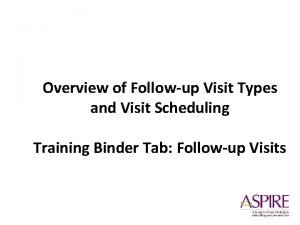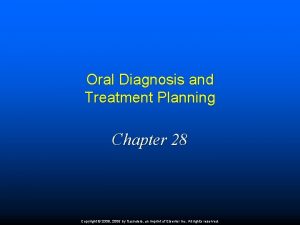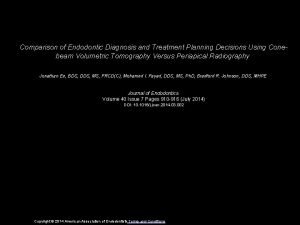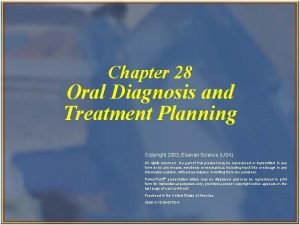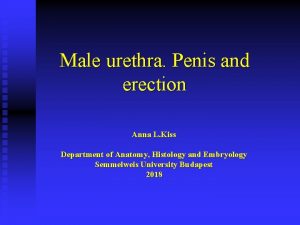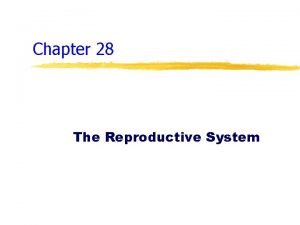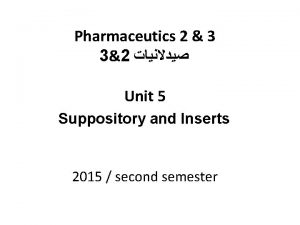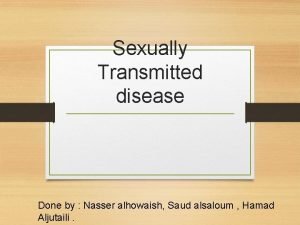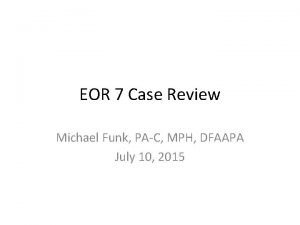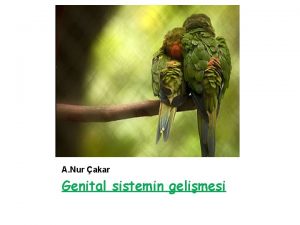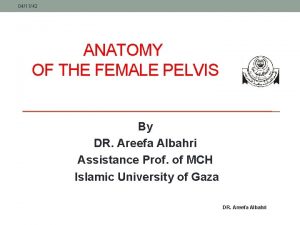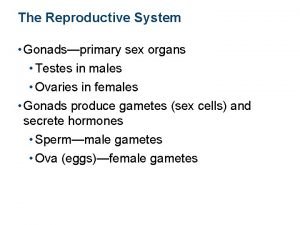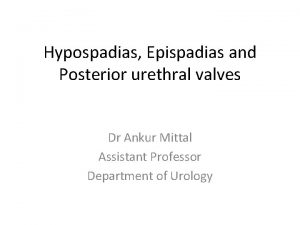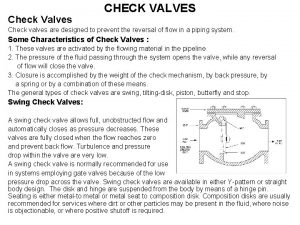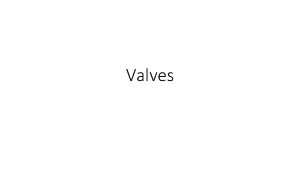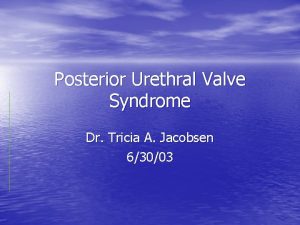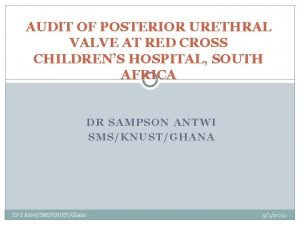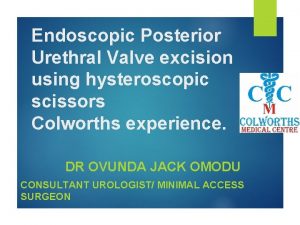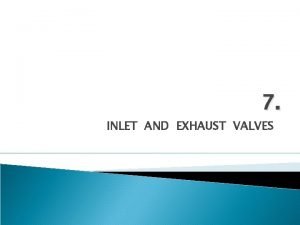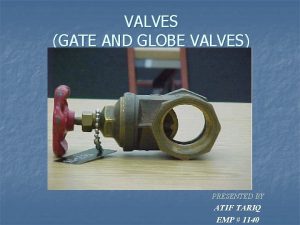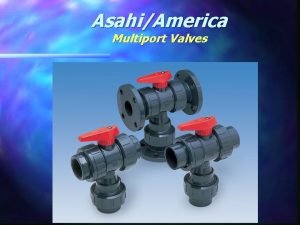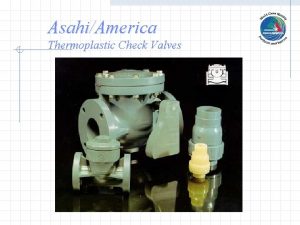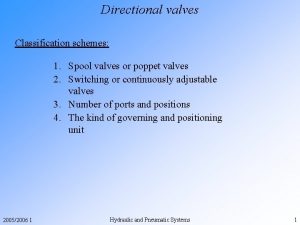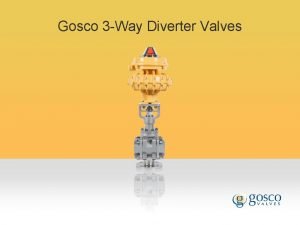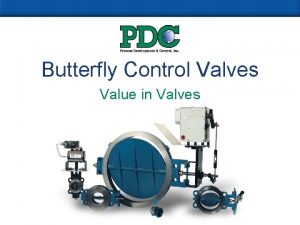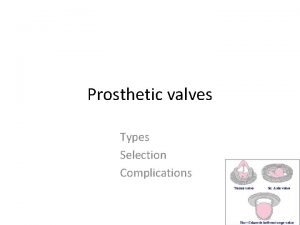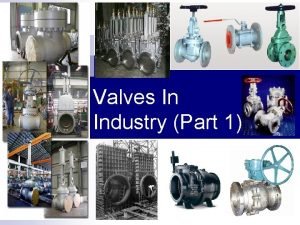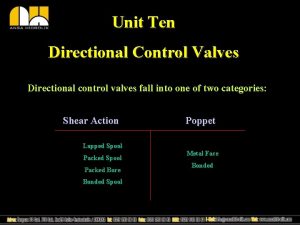Posterior Urethral Valves Diagnosis Treatment and FollowUp L






















- Slides: 22

Posterior Urethral Valves: Diagnosis, Treatment and Follow-Up L. Raffoul, MD Paediatric Urology Hôtel-Dieu de France, Beirut Second IPNA Teaching Course, Beirut, 13 -15 June 2019

What are PUV? • The most common congenital cause of bladder obstruction in boys. • The most common obstructive cause of endstage renal disease in children. • Small leaflets of tissue in posterior urethra, with a narrow opening that impedes urine outflow.

Young’s Classification of PUV 95% 5%

Embryology Gonzales, Posterior Urethral Valves and Other Urethral Abnormalities. Campbell’s Urology.

Prenatal Management

Prenatal Diagnosis: US • • • Hydronephrosis and ureteral dilation Distended bladder Distended posterior urethra Variable amniotic fluid Renal cysts Pulmonary hypoplasia in severe cases Differential diagnosis: Prune Belly and urethral atresia

The “keyhole” sign Dilated urethra Dilated bladder

Is hydronephrosis always bilateral? “Pop-off” valves: 1 - Massive unilateral vesicoureteral reflux into a nonfunctioning kidney 2 - Bladder diverticulum 3 - Urinary ascites

Renal function: Is it predictable? Fetal urine analysis: Sodium > 100 mmol/L β 2 microglobuline > 2 mg/L Kidney’s aspect on US: Dysplastic kidneys Echogenicity of parenchyma LONG-TERM renal function cannot be predicted! Gestational age at diagnosis: Less than 24 WG El Ghoneimi A et al. Long term outcome of prenatally detected posterior urethral valves: single center study of 65 cases managed by primary valve ablation. The Journal of Urology, 2008.

Prenatal Treatment Vesicoamniotic shunting Fetal endoscopic ablation of valves Fetal surgery should be reserved to cases with severe oligoamnios and “normal” renal function… 30% might develop end-stage renal disease despite prenatal treatment! Holmes N et al. Fetal surgery for posterior urethral valves: long-term postnatal outcomes. Pediatrics. 2001

Postnatal Management If diagnosis is suspected prenatally If diagnosis is not suspected prenatally Confirm the diagnosis • Palpable mass (dysplasia, urinoma) • Urinary infection, sepsis • Respiratory distress

Postnatal Diagnosis: US • At birth! • Experimented radiologist! - Bilateral hydroureteronephrosis Or unilateral dilation with dysplastic kidney Renal parenchyma, cysts Dilated bladder Dilated posterior urethra (“keyhole” sign)

Postnatal Diagnosis: VCUG

What should we do next? 1. Call the paediatric nephrologist! 2. Urinary diversion (transurethral or suprapubic). 3. Start prophylactic antibiotics. 4. Surgery. PLURIDISCIPLINARY APPROACH IS A MUST!

Postnatal Treatment

Surgical Treatment Endocopic valve ablation Temporary urinary diversion • Bugbee • Cold-knife • Laser • Small weight babies • Inadequate material 12 h 7 h 5 h Minimum time, Minimum trauma, Minimum irrigation

Follow-Up Creatinine VUR RENAL TRANSPLANTATION Bladder valve

Creatinine • 7 days after relieve of obstruction, and at 1 year. • <80μmol/l = good prognosis • >80 -105μmol/l = end-stage renal disease bound to happen! Sarhan OM et al. Posterior urethral valves: multivariate analysis of factors affecting the final renal outcome. J Urol 2011

Vesico-Ureteral Reflux (VUR) • 50% of PUV. • 25% will resolve spontaneously. • Surgery if persistent or if recurrent UTIs.

The Bladder Valve Non compliant, high pressure Compliant, big capacity, acontractile • Urodynamics • Anticholinergic and CIC • Bladder augmentation • Empty the bladder: CIC, Mitrofanoff INCONTINENCE

Conclusion PUV is more a medical condition than a surgical one! PUV is a chronic disease! Multidisciplinary approach is a must!

“Do you believe in love at first sight, or should I stop by again? ”
 Followup edge
Followup edge Followup:actionitems
Followup:actionitems Followup visit
Followup visit Nursing diagnosis examples
Nursing diagnosis examples Medical diagnosis and nursing diagnosis difference
Medical diagnosis and nursing diagnosis difference Medical diagnosis and nursing diagnosis difference
Medical diagnosis and nursing diagnosis difference Medical diagnosis and nursing diagnosis difference
Medical diagnosis and nursing diagnosis difference Charting identification chapter 28
Charting identification chapter 28 Diagnosis and treatment planning in complete denture pdf
Diagnosis and treatment planning in complete denture pdf Endodontic diagnosis and treatment planning
Endodontic diagnosis and treatment planning Chapter 28 oral diagnosis and treatment planning
Chapter 28 oral diagnosis and treatment planning Most common site of urethral injury
Most common site of urethral injury Ejaculatum
Ejaculatum Streptococcus pneumoniae csf
Streptococcus pneumoniae csf Labia minora glands
Labia minora glands Pencil shaped suppository
Pencil shaped suppository Erythema urethral meatus
Erythema urethral meatus Urethritis
Urethritis ÿout
ÿout Bladder mesoderm
Bladder mesoderm Androgen insensitivity syndrome
Androgen insensitivity syndrome External urethral orifice
External urethral orifice Penis glans
Penis glans


